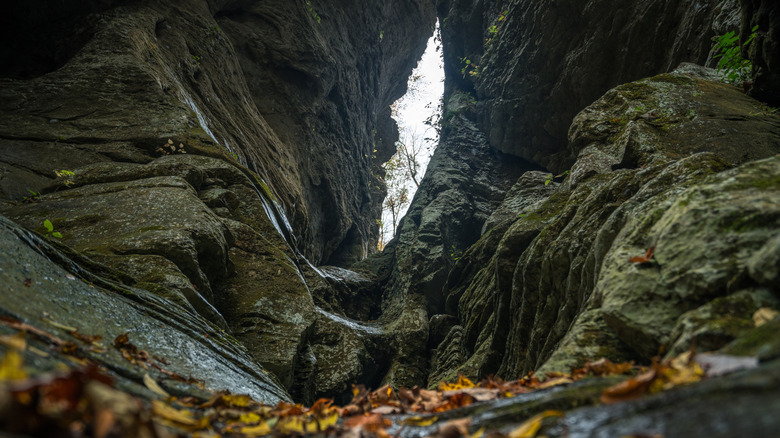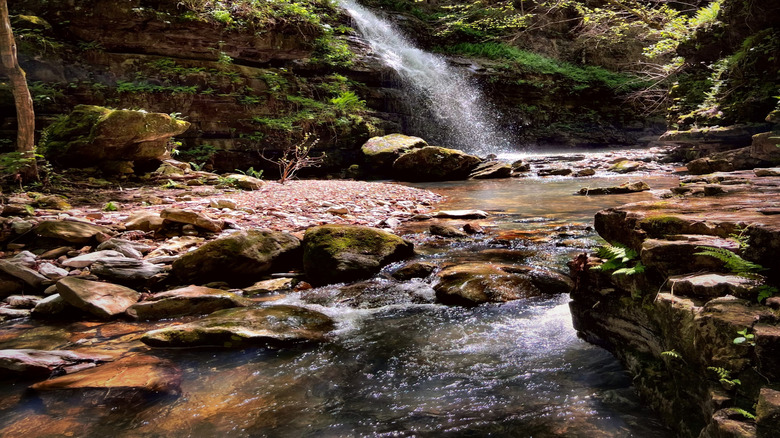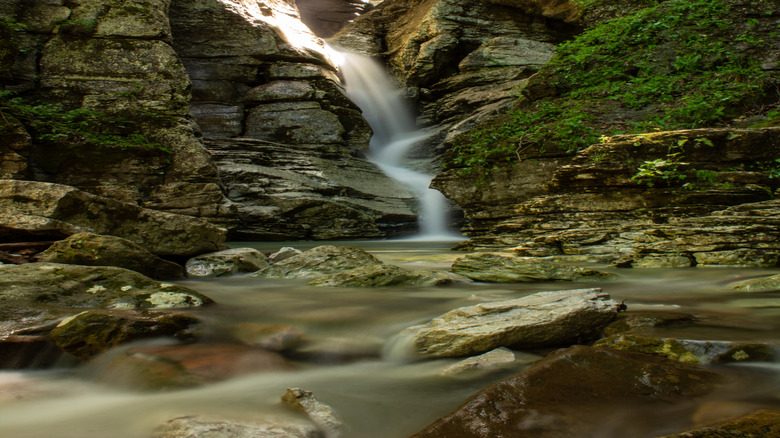Arkansas' Most Dangerous Day Hike Crosses Streams, Waterfalls, And Rock Scrambles To A Unique Rock Formation
The United States has a seemingly endless bounty of amazing hiking trails. However, many of these spectacular trails are also some of the world's most dangerous. Challenging and potentially perilous hikes aren't out of place in much of the country's rugged and mountainous landscape. Many people would assume that these formidable hikes are found in unforgiving national parks out west, like the popular but dangerous Angels Landing Trail in Utah's Zion National Park. Few would expect a top hiking challenge waiting in a seemingly tranquil river park in an unassuming state like Arkansas. And yet, Arkansas' demanding Indian Creek Trail ranks high among America's most challenging day hikes, with magnificent scenery to complement its hazards.
The Indian Creek Trail is a short but fearsome out-and-back trek through Arkansas' Buffalo National River. Though this overlooked National Park Service site protects a waterway, visitors can also find plenty of stunning forests and mountain adventures in the gorgeous parklands surrounding the Buffalo River. With a trailhead about three hours by car from the Bill and Hillary Clinton National Airport in Little Rock, Arkansas, the Indian Creek Trail is a rough and undeveloped hiking route that nevertheless traverses much of the Buffalo National River's most magical scenery. And while the trail's collection of blissful forest scenes, riverside cliffs, and epic waterfalls alone would make it a worthy hike, it's what's waiting at the end that takes the Indian Creek Trail to a whole other level. The centerpiece of the trail is the extraordinary Eye of the Needle, a striking rock formation that may be the top geological wonder in all of Arkansas — for those who manage to complete the risky hike.
Why the Indian Creek Trail is so dangerous
Unfortunately, the very rocky and wet terrain that makes the Eye of the Needle hike so scenic also makes it perhaps the single most dangerous hike in Arkansas. On paper, the full hike is only around 4.3 miles long. However, much of those 4.3 miles involves precarious scrambles over steep rocks and challenging boulders, with a few sections requiring straight-up vertical climbs up a steep rocky cliff ("luckily," this section has climbing ropes installed, so at least you won't have to free-hand it). High water levels — the same conditions that fuel the trail's ravishing waterfalls — also create slippery terrain, making the trail's rocky sections even more hazardous. Tragically, several hikers have lost their lives on the trail.
If you're up for the many challenges and risks involved, you'll begin the Eye of the Needle at Buffalo National River's Kyle's Landing campground. From there, you'll follow the rocky slopes around Indian Creek. At times, you'll have to wade through water and traverse the edge of rocky bluffs, all the while contending with the risk of potentially life-threatening falls. As you progress towards the Eye of the Needle, you'll ascend around 700 feet in elevation — though all the climbing and scrambling you'll be doing may make it seem like much more!
Fortunately, Kyle's Landing Campground makes a great base of operations, especially if you're staying overnight. Even if you're not up for the dangers and challenges of the hike to Eye of the Needle, Kyle's Landing provides convenient access to the other terrific trails in the Buffalo National River's Upper District, such as the easier Lost Valley Trail. Alternatively, Arkansas' beautiful Ozark mountain town of Jasper is less than 8 miles away.
What to see on the Indian Creek Trail
Despite being America's first national river, the Buffalo National River has a superb collection of land-based hiking trails as well. In fact, the full park protects around 95,000 acres of breathtaking mountain terrain. And while the water-carved cliffs and cave systems around the Buffalo River provide stiff competition, the remarkable Eye of the Needle may just be the park's most outstanding natural wonder.
The Eye of the Needle is a towering rock face along Indian Creek that's been sculpted by years of erosion into a natural arch. The arch's narrow and oblong shape gives it a distinctive "eye-shaped" appearance. Even more impressively, during periods of high water levels, Indian Creek spills over through the "eye" in a stunning waterfall. The Indian Creek Trail leading to the Eye of the Needle formation is also rich in other natural spectacles, including towering bluffs, lovely forest creeks, and scenic overlooks.
In particular, the trail's stark cliff faces, combined with ample natural water sources, create several more picture-perfect waterfalls you're likely to see along the trail. Arkansas is already a low-key waterfall-rich state, with outdoor destinations like Petit Jean State Park famed for crashing waterfalls and natural swimming holes. The Indian Creek Trail, however, may have them all beat with exceptional cascades like Tunnel Cave Falls and Copperhead Falls (not to mention the Eye of the Needle itself). Beyond the trail's waterfalls and rock formations lies the Ponca Wilderness, which boasts some of the most pristine views in the entire Buffalo National River.


